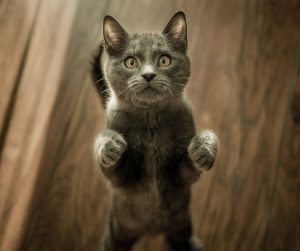Understanding Cat Body Language
by Dr. Noelle Weeks, Veterinarian, Veterinary Resource Center of the Humane Society of Harrisburg Area
Reading cat body language depends on not only observing the cat’s body cues but also observing the surroundings where the body cues are happening. The physical cues can have different meanings based on the context in which they are observed. A cat uses body position, tail position, ears, eyes, whiskers and vocalization to communicate.
Body posture. A cat willing to positively interact will have a neutral body and face you. A scared or stressed cat may try to puff up and arch their back or shrink into a small ball.
Tail. A high tail often means the cat is happy and confident, even friendly; sometimes the tail may quiver. A low tail could be a sign of  anxiety or fear. When a cat is flicking the tail, the cat is usually agitated and upset; this is a sign to not interact with the cat.
anxiety or fear. When a cat is flicking the tail, the cat is usually agitated and upset; this is a sign to not interact with the cat.
Ears. If a cat’s ears are high and erect and facing forward, the cat is alert, calm and confident. As the cat becomes stressed, fearful or upset, the ears will turn to the side and back. A cat with flattened ears is a cat to avoid.
Eyes. When looking at cat eyes, it is important to look at pupil size. It is important to interpret eye cues with other body cues to understand your cat’s behavior. When a cat’s pupils are dilated, large black center, the message is only that the cat is stimulated; this could mean stimulated to play or stimulated in fear or aggression. If a cat’s pupils are constricted, it could indicate aggression, high play arousal or be due to bright light.
Whiskers. If the whiskers are tight against the face, the cat is communicating fear and/or aggression.
Vocalization. Cats can make a lot of noises. Trills and purrs are generally associated with positive feelings; however, cats can purr during times of stress or pain. Cats can chirp or meow when they are either excited or frustrated. But a growl, a hiss, or a yowl are indications from the cat that they are feeling threatened and need you to back off.
Listed below are some combined physical cues which communicate your cat’s mood:
Content: Sitting or lying down, eyes half-closed, pupils narrowed, tail mostly still, ears forward and purring—a really happy cat will often knead on a soft surface.
Playful: Ears forward, tail up, whiskers forward and pupils somewhat dilated—playing is hunting behavior; your cat may stalk their prey (a toy, a housemate or you), then crouch down with their rear end slightly raised. A little wiggle of the butt, then…pounce! Your cat will grab their prey, bite it, wrestle it the floor and kick it with their hind feet: Their toy is now dead.
Irritated or over-stimulated: Pupils dilated, ears turned back and tail twitching or waving—your cat may growl or put their teeth on you as a warning to cease and desist. Intense play can quickly turn into overstimulation in some cats, resulting in biting and scratching.
Nervous or anxious: Ears sideways or back, pupils dilated and tail low or tucked between legs—your cat may slink through the house close to the floor, looking for somewhere to hide. They may turn their face to the wall to shut the world out.
Frightened or startled: Think Halloween cat—ears back and flat against their head, whiskers back, back arched, fur standing on end and tail erect or low. They may yowl, growl, hiss and spit.
Defensive: Crouched, ears flattened, whiskers back, tail between their legs or wrapped around their body, and pupils dilated—they may meow loudly, growl, hiss and spit.
Angry, aggressive: Ears back, pupils very constricted, and their tail may be up or down with the fur standing on end—an aggressive cat will stare down another cat and growl or yowl until the other cat gives way. Cats don’t really want to fight; they prefer standoffs, but this can progress to fighting if one of the cats doesn’t back down.
Paying attention to your cat’s body language will help you understand and develop a better relationship with your feline friend!
